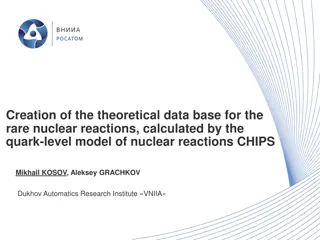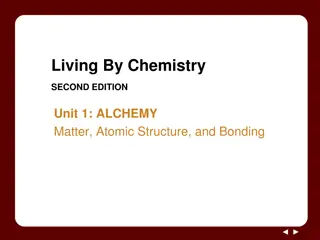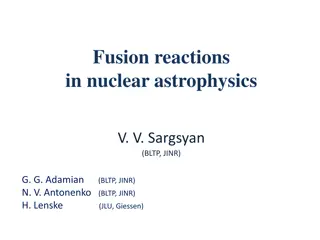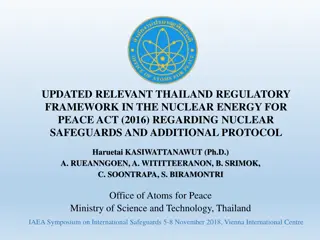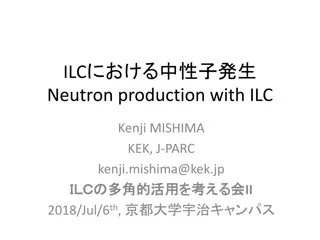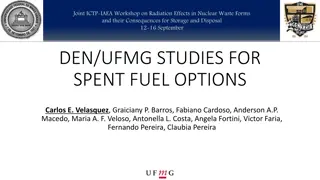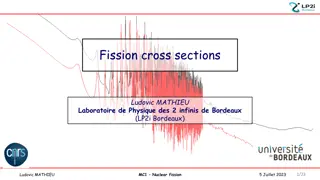Mechanisms and Models of Nuclear Reactions
The chapter discusses the reaction cross-section in nuclear reactions, including resonance and tunneling phenomena. It explains the probability of reactions occurring, the influence of nuclear radius on cross-section, and how tunneling allows reactions at energies lower than the Coulomb barrier. Examples highlighting various energy levels and excited states in nuclear reactions are also explored.
Download Presentation

Please find below an Image/Link to download the presentation.
The content on the website is provided AS IS for your information and personal use only. It may not be sold, licensed, or shared on other websites without obtaining consent from the author. Download presentation by click this link. If you encounter any issues during the download, it is possible that the publisher has removed the file from their server.
E N D
Presentation Transcript
Chapter 4 Mechanisms and Models of Nuclear Reactions 1
The Reaction Cross Section The probability for a nuclear reaction to occur is expressed in terms of the reaction cross-section. The geometric cross-section that a nucleus presents to a beam of particles is r2. If we use 6 10-15 m as an average value for the nuclear radius, the value of r2 becomes 3.14 (6 10-15)2 10-28 m2. 2
The Reaction Cross Section Fig 4.1: Excitation functions for reactions between 4He ions and 54Fe target nuclei. The kinetic energy of the projectile is in the laboratory system. 3
Resonance and Tunneling Experimentally, it is found that nuclear reactions sometimes occur at energies less than that required by the Coulomb barrier. This is called tunneling. As a projectile approaches a target nucleus in a nuclear reaction, the probability that there will be overlap and hence interaction of their wave functions increases. 4
Resonance and Tunneling An example is provided by the reaction of protons with lithium: (a) (b) (c) Remember that the Q value for a reaction is the amount of energy released by that reaction. For the above reaction the value of Ecb(min) is 1.3MeV. However, due to tunneling the reactions begin to occur at lower proton energies. At an energy of 0.15 MeV about 0.1% of the protons penetrate the Coulomb barrier, at 0.3 MeV about 1%, and at 0.6 MeV about 20%. The reaction cross-section is closely related to the excited energy states of the compound nucleus. 5
Resonance and Tunneling Four excited states levels are shown for 8Be* in the following example: Fig 4.2: Yield curves for the reaction between protons and 7Li, leading to different excited levels in 8Be, followed by decay to stable end products. 6
Resonance and Tunneling In the previous curve, to the left of the figure, the (p, ), (p, n), and (p, ) excitation functions are shown as function of the proton kinetic energy. The maximum cross-section for reaction (b) occurs at a proton kinetic energy of 0.44MeV, which, together with the Q- value, 17.2 MeV, of the reaction 7Li + 1H 8Be, leads to an excitation energy of 17.6 MeV, which exactly matches an excited level of the same energy in 8Be*. At an excitation energy of 19.18 MeV another energy level is reached in the compound nucleus leading to its decay into 7Be + n, reaction (c). The excitation energy is achieved from the release of nuclear binding energy (17.25 MeV) and from the proton kinetic energy. The amount needed is 19.18-17.25 = 1.93 MeV. In order to conserve momentum, the proton must have (8/7) 1.93 = 2.21 MeV in kinetic energy. The increase in cross-section when the total excitation energy matches an excited energy level of the compound nucleus is known as resonance. 7
Resonance and Tunneling Reaction (b) is still used for the production of -radiation (17MeV). While reaction (c) is used as a source of mono-energetic neutrons (neutrons having the same energy). The energy of the neutrons from reaction (C) is a function of the proton energy and the angle between the neutron and the incident proton beam. A necessary requirement, however, is that the threshold energy (1.64 (8/7) = 1.88 MeV) must be exceeded, the Q-value for reaction (C) being -1.64 MeV. 8
Neutron Capture and Scattering Unlike charged particles, no Coulomb barrier hinders neutrons from reaching the target nucleus. This leads to generally higher reaction cross-sections for neutrons, particularly at very low energies. Neutron-induced processes are among the most important and well studied nuclear reactions. We have seen that the geometric cross-section of a target nucleus is in the order 10-28 m2. Experimentally, the cross-sections for capture of energetic fast neutrons (En 1MeV) are often close to10-28 m2. However, for neutrons whose kinetic energy is in the range 1-100eV, some nuclei show very large cross sections- as high as 10-23 m2. This is due to electron capture where the compound nucleus is excited to one of its discrete energy levels (resonance capture). 9
Neutron Capture and Scattering For low energy (slow) neutrons (En<<1MeV) the cross-section is also larger than r2, and decreases as the velocity increases; According to matter-wave the wavelength associated with a moving particle is which can be written as: In effect, the wave properties make neutrons appear much larger than their geometric size and increases the probability of their interaction with the nucleus. It follows that: 10
Models for Nuclear Reactions No single model is successful in explaining all the aspects of the various types of nuclear reactions. Let us consider three models which have been proposed for explaining the results of nuclear reaction studies: 1. The Optical Model This model has been developed based on the mathematical techniques used in optics. Light shining on a transparent crystal ball is transmitted with some scattering and reflection with no absorption. Light shining on a black crystal ball is all absorbed but there is no transmission or scattering. 13
The Optical Model (continued) In nuclear reactions the incoming particles are scattered in elastic scattering and are absorbed in induced transmutations. Therefore, if a nucleus is to act as a crystal ball it can be neither totally transparent nor totally black. The optical model of the nucleus is also known as the doudy crystal ball model, indicating that the nuclei both scatter and absorb the incoming particles. The nucleus is described as a potential well containing neutrons and protons. The equation for the nuclear potential includes terms for absorption and scattering. This potential can be used to calculate the probability for scattering an incident particles and the angular distribution of the scattering. Unfortunately, this model does not allow us to obtain much information about the consequences of the absorption of the particles which lead to inelastic scattering and transmutation. 14
The Optical Model (continued) The approximate potentials for neutrons and protons take the general form shown at left below. 15
The Liquid-drop Model As the excitation energy of an excited nucleus increases, the energy levels get closer together. Eventually, a continuum is reached where the density of the nuclear levels is so great that it is no longer possible to identify individual levels. When the excited nucleus emits a proton or a neutron while in the continuum energy, the resulting nucleus may be still sufficiently energetic that it remains in the continuum region. 16
The Liquid-drop Model When a bombarding particle is absorbed by a nucleus, the kinetic energy of the bombarding particle plus the binding energy released by its capture provides the excitation energy of the compound nucleus. In this model, the compound nucleus becomes uniformly excited in a manner somewhat analogous to the warming of a small glass of water upon addition of a spoonful of boiling water. 17
The Liquid-drop Model As the nucleons move about and collide in the nucleus, their individual kinetic energies vary with each collision just as those of molecules in a liquid change in molecular collisions. As this process continues, there is an increase in the probability that at least one nucleon will gain kinetic energy in excess of its binding energy. That nucleon is then evaporated (i. e. leaves the nucleus) analogously to the evaporation of molecules from liquid surfaces. 18
The Liquid-drop Model The evaporation of the nucleon decreases the excitation energy of the residual nucleus by an amount corresponding to the binding energy plus the kinetic energy of the released nucleon. The evaporation process continues until the residual excitation energy is less than the binding energy of the nucleon. The excitation energy remaining at this point is removed from the nucleus by emission of rays. 19
The Liquid-drop Model Assume that the compound nucleus is formed with a total excitation energy of 20 MeV. If the average binding energy of a neutron is 6 MeV and if each neutron leaves with 3 MeV of kinetic energy, evaporation of a neutron de- excites the nucleus by 9 MeV. Therefore evaporation of two neutrons would leave the residual nucleus with an excitation energy of only 2 MeV. Since this is below the binding energy of a neutron, further evaporation is not possible and -ray emission removes the final 2 MeV. If the compound nucleus was formed by -bombardment of the reaction is represented as : 20
The Life-time of The Compound Nucleus An important assumption of the compound nucleus theory is that the nucleon system is held together long enough for the energy to be shared by all nucleons. It is assumed that the time it takes for the accumulation on one nucleus of enough energy to allow evaporation is even longer by nuclear standards. This time is of 10-14 s as compared to a time of 10-20 s required for a nucleon to cross the nuclear diameter once. Themode of decay is independent of the mode of formation and only depend on the amount of excitation energy, the nuclear temperature (expressed in MeV). For example, the Dysprosium can be formed in two ways: 21
The Life-time of The Compound Nucleus Both form the excited form The probability of the formation of is dependent only on the excitation energy of the compound nucleus but not on the manner in which the compound nucleus is formed. 22


